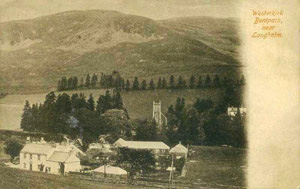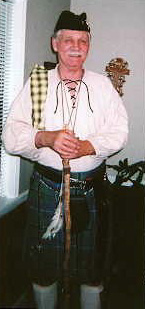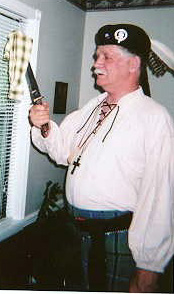
Glendinning Westerkirk
People have always had a hard time saying my name but it’s not that difficult. It has three syllables not twelve. Clen-den-in. Granted, as a child I might stumble over it as I hid my face in shame. When someone has trouble with it they often exaggerate their discomfort with something like Clendenininininin. My son, a first grade school teacher and High School Coach, has remedied their awkwardness by having them call him “Mr. C”.
The name is Scottish/Gaelic in origin and goes all the way back to the thirteenth century. It has also undergone variant spellings. Clendening, or Clendenen, or McClendenin, or as originally thought, Glendonwyn. In those days of yore ones sir name was derived from the place where the original bearer once lived. In our case, the name indicates “One who came from the lands of Glendinning (Glen of the Fair Hill) in Westerkirk, Dumfriesshires.

Glendinning Westerkirk
Once upon a time my daughter Jennifer purchased one of those family Genealogical print-outs from a kiosk in the local mall. I was skeptical at first, thinking it was one of those generic documents like the generalities a palm reader might employ, but as it turns out the information was consistent with my own further research. References were made to William de Glendonwyn who was procurator of the Scottish “Nation” at the University of Orleans in 1408. In that same year Matthew de Glendowyn was Bishop of Glasgow. And here I thought I was the first Minister in our family.

SEPT. DOES NOT MEAN SEPTEMBER
A Clan that is under the protection and often employment of a Lord or a large land owner is called a Sept. They are expected to join with the Chieftain in matters of war and dispute. They are what we would call today “Tennant Farmers” or Sharecroppers. The Clendenins were a Sept of the Douglas Clan, a large and powerful Clan who stood with King Robert the Bruce of Scotland during the war of independence from England, 1296-1328.
In 1321 Adam Glendonwyn received a grant of land as a reward for his military service under Sir James “the Black” Douglas. The lands were along the River Esk two miles from the present town of Langholm in Dumfrieshire, Scotland, around 20 miles north of Scotland’s border with England.
Langholm, Scotland - Near Glen Of The Fair Hill
The Clendenins continued to thrive and descendants continued to fight in the War of the Spanish Succession. When William Clendenin left the war in Europe, he returned home to growing political disease. He brought back with him bitter feelings about the abolishment of his home church. When William’s son was born, he named him Charles as an act of defiance. Charles was a very unpopular name for a child and swimming against the tide, the Clendenins held to their Anglican religious beliefs. At that time the principle of “to the victor belong the spoils” was a common practice, so William came home to Scotland with some pocket change. This same principle would reappear in family folk tales when at the end of the American Civil War, 1st Lt. Joseph Armstrong Clendenin was on a mission to round up horses for the Confederacy. While on his assignment the war ended and Joseph returned to Wayne Co. Tennessee with a healthy herd. There is evidence that the Clendenins participated in the Jacobite Rising and were forced to flee to Northern Ireland.
Langholm, Scotland - Near Glen Of The Fair Hill
Photo by the author
There are few official records kept in Ireland so births and marriage documentation is sparse. About the same time, the infamous hard winter of 1739 (known as the black frost) caused hundreds of Scotsmen to immigrate to America. During this time Charles, William Jr., and Archibald Clendenin came to America.
In 2016 my brother Joe Bob Clendenin, his daughter Laurie and I took a week-long trip to Scotland. Seeing sites like Edinburgh Castle, the many Cathedrals, Glencoe, Sterling Castle and the hundreds of monuments covered with “Patina” from many hundreds of years of industrial pollution made what had previously seemed like a fairytale a kinesthetic experience. These places are real.
Sterling Castle
Photo by the author
The Heraldry & Coat of Arms
With the recent revival in families interested in genealogy, the public has become parched for any information about their heritage and more recently their DNA footprints. That said, most of us are gullible to any information we can retrieve – including this document. While a Coat of Arms or a family Tartan pattern may not have been actually accurate or even used at all is mostly speculation. The Coat of arms that I am displaying is just as good as another.
Clendenin Coat Of Arms
THE WEARING OF THE TARTAN & KILT
In an effort to reign in the Scottish Clans that supported the Jacobite uprising, the Act of Proscription forced the Highland Scotts to stop wearing their Clan Tartan and traditional Kilts. The Scottish Presbyterians defied this Dress code act of 1746 by hiding strips of their clans Tartan under their clothing and once a year they would hold a “Kirkin’ of the Tartans” to bless their clan. “Kirk” is the Scottish/Celtic word for “Church.” In time this practice was absorbed and eventually disappeared until the late Rev Peter Marshal, Chaplain of the U.S. Senate reintroduced this service of blessing in his own church. It has become a growing popular service now for many years.
It is for that reason that I wear the Douglas Tartan and I wear my Kilt at the slightest appropriate events and always on the third Sunday of May which is designated as Presbyterian Heritage Sunday. I have also worn it at over 20 Native American Inter-tribal Powwow’s. I have been named as honorary Tribal Spiritual Elder of an Inter-tribal group called Native Solutions. I find this ironic as we shall see in later pages that Archibald Clendenin was massacred and scalped by Shawnee Chief Cornstalk.
I have chosen to use the black and yellow sleeve of the plaid shirt I was baptized in at the age of 12. It’s a miracle my Mom saved the shirt. I wear it on my right shoulder as an applet.



The author in Scottish Kilts